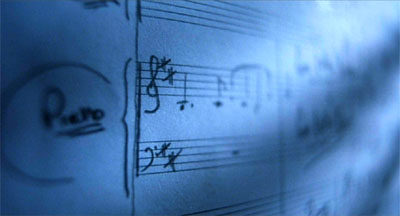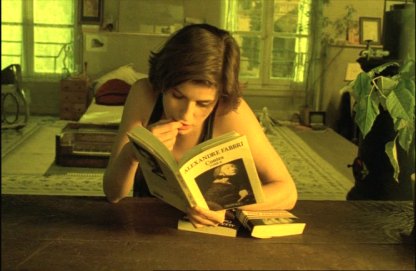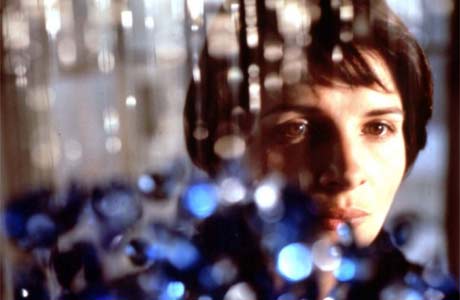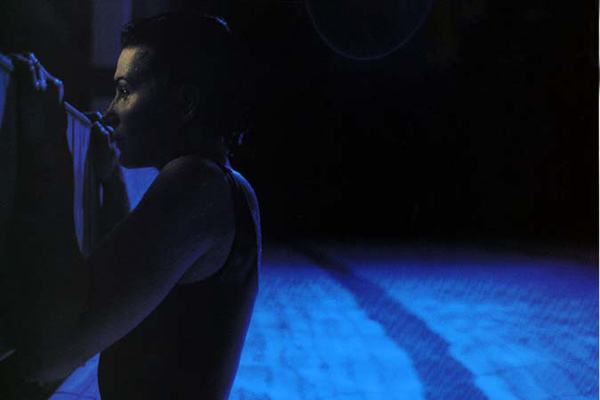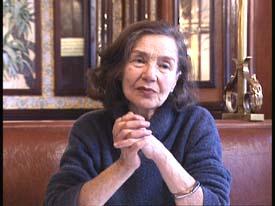From the Chicago Reader (February 11, 1994). — J.R.
*** BLUE
(A must-see)
Directed by Krzysztof Kieslowski
Written by Kieslowski and Krzysztof Piesiewicz
With Juliette Binoche, Benoit Regent, Florence Pernel, Charlotte Very, Helene Vincent, Emmanuelle Riva, and Philippe Volter.
Indisputably the work of a master, to a much greater degree than anything else around at the moment, Krzysztof Kieslowski’s first feature without reference to his native Poland is sufficiently contemporary and allegorical to take the future of Europe, and a “unified” Europe at that, as one of its themes. Palpably concerned with loss and regeneration, suffering and transcendence, Blue calls to mind some of the better late works of Ingmar Bergman in its powerful sense of dramatic concentration; it doesn’t have quite the undertow of neurosis that presumably made those films so exemplary for Woody Allen, but it does have a much bolder grasp of the movements and vagaries of consciousness.
In the opening moments of Blue the leading character, Julie (Juliette Binoche), loses both her husband, a famous French composer, and her five-year-old daughter in a car crash; the remainder of the film charts her mental and spiritual recovery. The film’s remarkable economy is already apparent in the opening shot — a close-up of the spinning right front wheel of the car, seen from behind, as it speeds down a highway. When the accident occurs, sound economically replaces image, a procedure often followed by Robert Bresson: a boy on the foggy road hears the crash, and only then do we cut to a shot of the wrecked car against a tree. (Much later in the film, this attention to the sound track produces a Hitchcockian tour de force in which Julie, alone and frightened in her upstairs apartment, hears someone rush into her building and knock on several doors on the floors below before reaching hers.)
As beautifully and strikingly articulated as this story is, both in its moment-to-moment experience and in its overarching meanings, the film is still arguably something less than a masterpiece. Set in France with dialogue solely in French — a language that, unlike English, Kieslowski isn’t able to handle without an interpreter — the film can’t help but implicitly make predictions about the future of European cinema, and it’s here that its problems start. For if it’s the fate of European cinema to become as nonspecific and allegorical as this movie, then what we’re talking about is the death of certain things (like the Polish and French cinema) as well as the rejuvenation of other things (like a European art cinema — and one distributed by Disney, as this movie is). And because Blue is about death and rejuvenation, there are ways in which it describes the conditions of its own making — much as Kieslowski’s previous feature, The Double Life of Veronique, was implicitly about, as well as formed by, the very principles of European coproduction.
Veronique had two heroines and two nationalities, Polish and French, mystically “twinned” by the narrative. Blue is the first part of a Kieslowski trilogy called “Three Colors,” which has already been written and shot in its entirety; part two, White, will soon premiere at the Berlin film festival, and Red is supposed to surface later this year. Just as Kieslowski’s Decalogue proposed ten loosely connected fiction films structured around illustrations of the Ten Commandments, “Three Colors” is devoted to the three colors (blue, white, and red) and three abstract virtues (liberty, equality, and fraternity) associated with the French flag and the French Revolution. In keeping with the three-part idea, however, the trilogy will be set mainly in three countries — France, Poland, and Switzerland — and, like the Decalogue, it will have a few characters and settings that overlap. This makes it simultaneously French and non-French — a tactic that has won Kieslowski the scorn of some French critics, who seem somewhat skeptical about this Common Market idealism being paraded under the French flag, especially when France’s position on government subsidies for things like food and the arts differs radically from other European countries’ positions. (The somewhat ersatz Frenchness here suggests the postmodernist Hollywood noir exercises by British and European directors, such as The Grifters and Romeo Is Bleeding, where plots are confusingly neither period nor contemporary but ambiguous conflations of the two.) Thus Kieslowski, in addition to being a master, could also be called something of a cynic and opportunist — not to mention formalist, religious mystic, and black humorist. And as a filmmaker who developed his style in Eastern Europe during a highly repressive period, he might even be regarded as duplicitous.
It seems worth examining briefly some of the reasons our grasp of Kieslowski in the U.S. tends to be both confused and incomplete. The main reason his major work, the Decalogue, continues to be unavailable here is that the North American rights were purchased in 1990 by an eccentric distributor who has demanded exorbitant prices for it and has so far had no takers; in Europe it has been seen widely on television, in theaters, and on video. The full Decalogue did make it to the Chicago International Film Festival a few years ago, though I’m sorry to say I’ve been able to see only about half of it.
Not counting the unreleased White, the Decalogue is Kieslowski’s latest all-Polish film, in terms of production as well as language. For almost a quarter century he made Polish films: for the first decade (roughly 1966-’76) he made almost exclusively documentaries for television; for the next decade (roughly 1976-’87) he made narrative features for theaters and documentaries; and then he made narrative films for television, which in a couple of cases — A Short Film About Killing and A Short Film About Love — were expanded into theatrical features.
In December 1981, when martial law was declared in Poland, Kieslowski, a card-carrying Solidarity member, became interested in filming, as he put it, “the tanks, clandestine news-sheets, and anti-communist slogans daubed on walls.” He was especially interested in filming the stiff sentencing of political prisoners who’d engaged in such activities, all in support of Solidarity. Eight months later, after finally being granted permission to proceed, he discovered that the presence of his camera in the courtroom so intimidated the judges, who feared future reprisals, that they wouldn’t hand out jail sentences. Consequently, Kieslowski writes, “While it was still officially possible, I used to set up two cameras in the courts without even bothering to check whether they were loaded with film or not.” (It’s a story that irresistibly calls to mind Camera Buff [1979], Kieslowski’s first widely shown feature, in which a factory worker who buys a camera and proceeds to shoot anything and everything winds up being branded a subversive.)
Though the proposed film was understandably never made, one of the lawyers who encouraged Kieslowski to remain in the courtroom, Krzysztof Piesiewicz, was invited by Kieslowski two years later to collaborate on a script for a feature based on these experiences, No End (1984). The two men became good friends, and soon after the release of No End, Piesiewicz proposed that Kieslowski make a film about the Ten Commandments, which eventually became the Decalogue. (Kieslowski describes himself as not very religious; Piesiewicz describes himself as a Christian rather than a Catholic.) Piesiewicz also came up with the root concept of “Three Colors” and coauthored the scripts for those three films as well as for the Decalogue and The Double Life of Veronique, which implies that when people speak nowadays about Kieslowski as a creative force, they may mean a less commercially packageable entity consisting of Kieslowski and Piesiewicz.
One final consideration: Most of us know Kieslowski from the time he became internationally famous with the Decalogue, a project that can be read as an immediate response to Poland’s Cinema Act of 1987, which withdrew government support from the film industry. Kieslowski got major funding from Polish TV by coming up with the commercially exportable series related to the Ten Commandments, which minimized the more political aspects of everyday life in Poland and concentrated on the characters’ inner lives, borrowing notions about continuity between episodes from soap opera. In exchange for agreeing to make feature-length versions of two of the episodes, he got further backing from Poland’s Tor studio, and bringing in Germans as coproducers gave him access to 35-millimeter film stock. In The Double Life of Veronique and “Three Colors” one can see signs of the same kind of commercial deliberations informing his style as well as his content.
Stanley Kubrick, who has almost never praised any of his filmmaking contemporaries, wrote the very brief foreword to the English edition of the Decalogue screenplays. The single virtue he chooses to applaud in the work of Kieslowski and Piesiewicz is their “very rare ability to dramatize their ideas rather than just [talk] about them. By making their points through the dramatic action of the story they gain the added power of allowing the audience to discover what’s really going on rather than being told. They do this with such dazzling skill, you never see the ideas coming and don’t realize until much later how profoundly they have reached your heart.”
Significantly, Kubrick, by reputation the most intellectual and least emotional of filmmakers, places his emphasis on the heart instead of the head. What’s revealing as well as apt about his praise is how it highlights one of the few traits he can be said to share with Kieslowski and Piesiewicz — a kind of concentrated and maniacal emotional intensity that all but collapses narrative continuity and coherence in any ordinary sense for the sake of emotional impact. There’s a climactic moment in Blue when the image suddenly goes out of focus, and comparable junctures when fade-outs to black accompanied by bursts of music suddenly interrupt the heroine’s consciousness as well as our own. There are no obvious or precise equivalents to this in Full Metal Jacket, but the centerless narrative drift of most of the film’s second section, set in Vietnam, is comparably disorienting and similarly indicative of certain kinds of emotional disorder. (To the best of my knowledge, only one critic has even tried to deal with this drift as central to the film: Bill Krohn, in an excellent review in the sixth issue of Zone, a 1992 collection also known as “Incorporations.”)
The narrative breakdowns in the latter portions of The Shining provide another example of what I mean. The “ideas” dramatized here, which resist verbal paraphrase, may come across as both pea-brained and profound, naive and sophisticated, to viewers with literary training — but they’re so successful at emotionally implicating the viewer that one’s intellectual response to what’s going on shouldn’t necessarily be regarded as the most important one. Still, one can’t exactly reject one’s intellectual response, which makes for a curiously unresolved and conflicted experience.
In Blue one has to contend for long stretches with the grandiose notion of an unfinished concerto composed by Julie’s late husband that she initially decides to junk and eventually decides to complete with the help of a friend and lover named Olivier (Benoit Regent). Commissioned, we’re told, by the European Council to be performed simultaneously by a dozen symphony orchestras in the Common Market capitals, this “concerto” (we’re never told for what instruments) is in part a musical setting for a passage from chapter 13 of the first Epistle of Paul to the Corinthians. In the King James Bible this passage reads in part, “Though I have the gift of prophecy, and understand all mysteries, and all knowledge; and though I have all faith, so that I could remove mountains, and have not charity, I am nothing.” The English subtitles substitute “love” for “charity,” and Kieslowski, in an interview in the French film magazine Positif, insists that “love” and not “charity” is textually accurate, even though the interviewers suggest that “charity” is standard in French. (Is he referring to the Polish New Testament? Or could he have some new multilingual Common Market edition of scriptures in mind?)
Clearly this musical composition is set up as some sort of objective correlative for Julie’s life, which is also in the process of being repaired and restored — a pretty corny idea. Yet this conceit makes possible the film’s extraordinary final sequence, during which we hear the concerto’s climactic passage for the first time while we see all the major characters in the film in separate locations, magically linked by a series of dreamy pans, with long patches of darkness between islands of light — a highly dramatic, cinematic rendering of a dubious notion that literally took my breath away.
A lot of Blue has this disconcerting dual nature, though sometimes apparently intuitive plot turns come across as merely silly, even when the deadpan Polish humor is intentional. Prior to taking up and revising her late husband’s concerto, Julie sells everything in their chateaulike house and finds a flat near Paris’s student quarter, on the Rue Mouffetard, where she hides out from virtually everyone she knows. Among her experiences is her horrified discovery of a litter of mice inside a closet, which makes her flee thepremises. In desperation she calls on a real estate agent she knows who idly mentioned having a cat and asks to borrow it for a couple of days. Without any hesitation, the agent scoops up the animal and hands it over to her — without anything so mundane as a carrying case or feeding instructions — and she promptly walks home with it, deposits it inside her closet, and shuts the door. End of anecdote.
Yet such moments are silly only if one is looking for a reasonable story. Seen in purely formal terms, the film as a whole can be regarded as a concerto for the remarkable Juliette Binoche, regardless of whether one can accept the abrupt shifts, absences, anomalies, and mystical chance encounters in the story line, it’s a highly musical, emotional piece of filmmaking in which Binoche functions as the solo instrument. The cool orchestration and harmony behind the melody can often be found in the use of the title color itself, which figures in such details as a set of glass crystals from her married life that she hangs in her new apartment, a swimming pool where she does laps, a leftover lollipop with a blue wrapper that reminds her of her daughter, and a succession of TV screens.
One of these TV screens is perpetually watched by Julie’s mother, who’s stuck in a reverie between dream and reality as she rots away in a rest home; the actress playing her is the emotionally vibrant Emmanuelle Riva, who starred in Hiroshima, mon amour 35 years ago — Binoche’s actorly ancestor in more ways than one. However, though Binoche might be regarded as the legitimate daughter of the French New Wave, Blue is the illegitimate offspring of Poland and France — and a postmodernist composite of authentic soul and Eurotrash slickness from both countries. The final Polish irony/ambiguity is that, behind the mask of a French film about “liberty” in all its existential ambiguity — and somewhere inside a prepackaged piece of cheese about the unification of Europe — this is a movie in which Kieslowski’s own liberty manages to sing and soar.



